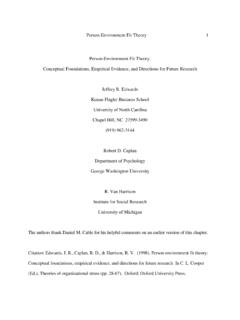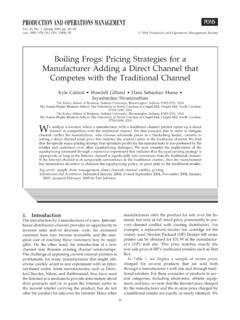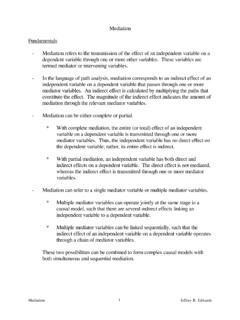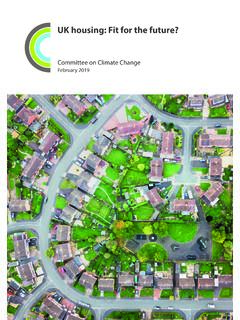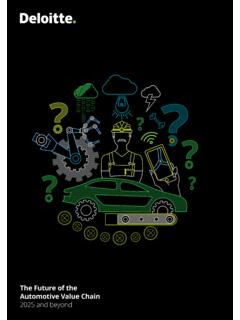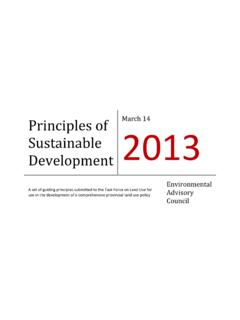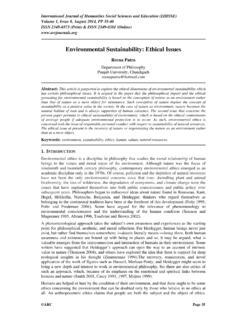Transcription of Person-Environment Fit Theory Person-Environment Fit ...
1 Person-Environment Fit Theory 1. Person-Environment Fit Theory : Conceptual Foundations, Empirical Evidence, and Directions for future Research Jeffrey R. Edwards Kenan-Flagler Business School University of North Carolina Chapel Hill, NC 27599-3490. (919) 962-3144. Robert D. Caplan Department of Psychology George Washington University R. Van Harrison Institute for Social Research University of Michigan The authors thank Daniel M. Cable for his helpful comments on an earlier version of this chapter. Citation: Edwards, J. R., Caplan, R. D., & Harrison, R. V. (1998). Person-Environment fit Theory : Conceptual foundations, empirical evidence, and directions for future research. In C. L. Cooper (Ed.), Theories of organizational stress (pp. 28-67). Oxford: Oxford University Press.
2 Person-Environment Fit Theory 2. Theories of stress have long recognized the importance of both the person and environment in understanding the nature and consequences of stress. Person constructs relevant to stress research include Type-A behavior (Friedman & Rosenman, 1959), locus of control (Rotter, 1966), hardiness (Kobasa, 1979), and coping styles (Menaghan, 1983). The environment has been construed as stressful life events (Rabkin & Struening, 1976), daily hassles (DeLongis, Coyne, Dakof, Folkman, & Lazarus, 1982), and chronic stressors such as role conflict and ambiguity (R. Kahn, Wolf, Quinn, Snoeck, & Rosenthal, 1964; Jackson & Schuler, 1985), role overload and underload (French & Caplan, 1972), and job demands and decision latitude (Karasek & Theorell, 1990).
3 This dual emphasis on the person and environment in stress research is characteristic of the interactive perspective in psychology (Lewin, 1951; Magnusson & Endler, 1977; Murray, 1951; Pervin, 1989), which indicates that behavior, attitudes, and well-being are determined jointly by the person and environment . The contributions of the person and environment to stress have been formalized in the Person-Environment (P-E) Theory of stress (Caplan, 1983, 1987a,b; Caplan & Harrison, 1993;. French, Caplan, & Harrison, 1982; French, Rodgers, & Cobb, 1974; Harrison, 1978, 1985). The core premise of P-E fit Theory is that stress arises not from the person or environment separately, but rather by their fit or congruence with one another. This simple yet powerful notion is reflected in numerous theories of stress and well-being (Cummings & Cooper, 1979; Edwards, 1992; McGrath, 1976; Rice, McFarlin, Hunt, & Near, 1985; Schuler, 1980) and is largely responsible for the widespread impact of P-E fit Theory in stress research (Edwards & Cooper, 1990; Eulberg, Weekley, & Bhagat, 1988).
4 The purpose of this chapter is threefold. First, we provide a conceptual overview of P-E. fit Theory , defining its core constructs and examining its basic mechanisms. This overview Person-Environment Fit Theory 3. encompasses presentations of P-E fit Theory from the original work by French and colleagues (French & R. Kahn, 1962; French et al., 1974) through later developments and refinements by Caplan (1983, 1987a,b), Harrison (1978, 1985), and Edwards (1996; Edwards & Cooper, 1990). Second, we summarize empirical research relevant to P-E fit Theory , including the original studies conducted at the Institute for Social Research at the University of Michigan (Caplan, Cobb, French, Harrison, & Pinneau, 1980; French et al., 1982) and other studies relevant to the basic propositions of P-E fit Theory (Assouline & Meir, 1987; Edwards, 1991; Michalos, 1986.)
5 Spokane, 1985). Third, we discuss conceptual and methodological issues pertaining to future research into P-E fit Theory . As this discussion will show, existing research has addressed only the most basic propositions of P-E fit Theory , and many unanswered questions regarding the meaning and consequences of P-E fit remain to be investigated. Collectively, these questions constitute an agenda for a second generation of P-E fit research that may substantially advance our knowledge of how the person and environment combine to influence stress and well-being. Overview of P-E Fit Theory Conceptual Foundations Basic concepts and distinctions. As noted previously, the fundamental premise of P-E fit Theory is that stress arises from misfit between the person and environment . The core elements of the Theory are shown in Figure 1, which depicts three basic distinctions central to P-E fit Theory .
6 The first and most basic distinction is between the person and environment . This distinction is a prerequisite for the conceptualization of P-E fit and provides the basis for examining reciprocal causation between the person and environment . The second distinction is between objective and subjective representations of the person and environment . The objective person refers to attributes of the person as they actually exist, whereas the subjective person Person-Environment Fit Theory 4. signifies the person's perception of his or her own attributes ( , the person's self-identity or self-concept). Analogously, the objective environment includes physical and social situations and events as they exist independent of the person's perceptions, whereas the subjective environment refers to situations and events as encountered and perceived by the person.
7 As shown in Figure 1, the objective person and environment are causally related to their subjective counterparts (Harrison, 1978). These relationships are imperfect due to perceptual distortions ( , repression, denial), cognitive construction processes (Weick, 1979), limited human information processing capacities (March & Simon, 1958), and organizational structures that limit access to objective information (Caplan, 1987b; Harrison, 1978).. Insert Figure 1 About Here . The two distinctions described above combine to yield four types of correspondence between person and environment constructs: (1) objective P-E fit, which refers to the fit between the objective person and the objective environment ; (2) subjective P-E fit, or the fit between the subjective person and the subjective environment ; (3) contact with reality, meaning the degree to which the subjective environment corresponds to the objective environment ; and (4) accuracy of self-assessment (or accessibility of the self; French et al.)
8 , 1974), representing the match between the objective person and the subjective person (Caplan, 1983; French et al., 1974; Harrison, 1978). Initial presentations of P-E fit Theory (French et al., 1974; Harrison, 1978) indicated that good mental health is signified by minimal discrepancies on objective P-E fit, subjective P-E fit, contact with reality, and accuracy of self-assessment. However, subsequent refinements of the Theory (Caplan, 1983, 1987a,b; French et al., 1982; Harrison, 1985) point out that objective P-E. Person-Environment Fit Theory 5. fit has little impact on mental health unless it is perceived by the person and thereby translated into subjective P-E fit (cf. House, 1974; R. Kahn et al., 1964; Lazarus & Folkman, 1984). Moreover, Caplan (1983) notes that, when stressors are potentially overwhelming, some disengagement from objective aspects of the situation or self may dampen anxiety and facilitate adaptation, thereby promoting mental health (Lazarus, 1983; Taylor & Brown, 1988).
9 Hence, current treatments of P-E fit Theory emphasize subjective P-E fit as the critical pathway to mental health and other dimensions of well-being. The nature of the relationship between subjective P-E. fit and well-being is examined in greater detail later in this chapter. A third distinction shown in Figure 1 differentiates two types of P-E fit. The first involves the fit between the demands of the environment and the abilities of the person. Demands include quantitative and qualitative job requirements, role expectations, and group and organizational norms, whereas abilities include aptitudes, skills, training, time, and energy the person may muster to meet demands. A second type of P-E fit entails the match between the needs of the person and the supplies in the environment that pertain to the person's needs.
10 P-E. fit Theory characterizes needs in general terms, encompassing innate biological and psychological requirements, values acquired through learning and socialization, and motives to achieve desired ends (French & R. Kahn, 1962; Harrison, 1985). Supplies refer to extrinsic and intrinsic resources and rewards that may fulfill the person's needs, such as food, shelter, money, social involvement, and the opportunity to achieve (Harrison, 1978). Commensurate person and environment constructs. For both needs-supplies fit and demands-abilities fit, P-E fit Theory requires that person and environment constructs are commensurate, meaning they refer to the same content dimension. For example, needs-supplies fit regarding achievement should entail the comparison of need for achievement with Person-Environment Fit Theory 6.
